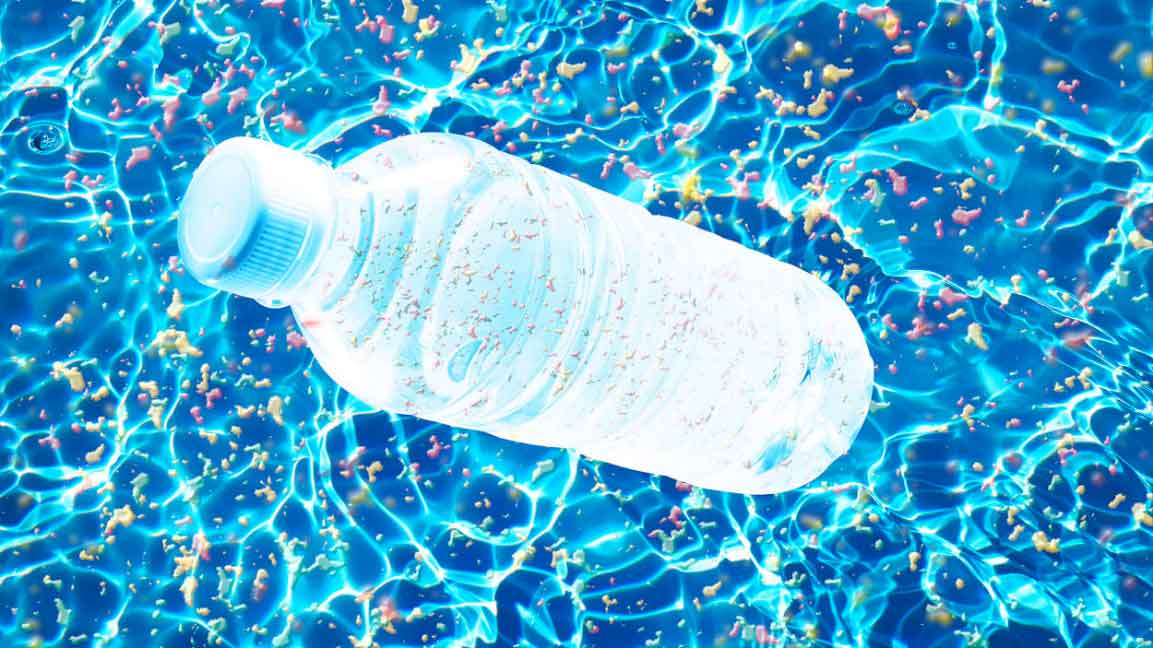- | 9:00 am
Your bottled water could contain 130,000 microscopic pieces of plastic
New research found that bottled water is filled with hundreds of thousands of nanoplastics—which could be even more toxic than microplastics.

Plastic is everywhere, and when it breaks down, its microscopic fragments end up in even more places than we could have imagined—seafood, salt, the crop roots, even dropped onto remote areas of national parks after being carried by the wind and rain. In all those instances, researchers have found evidence of microplastics, which range from 5 millimeters (about the size of a pencil eraser) to a micrometer (1/25,000th of an inch). But there’s a hidden world of even smaller plastic pollution: nanoplastics, or particles smaller than one micrometer—and, it turns out, hundreds of thousands of them have been found in bottled water bought off store shelves.
“Previously, [nanoplastics] was a dark field,” says Beizhan Yan, an environmental chemist at Columbia University’s Lamont-Doherty Earth Observatory, as the pieces of plastic are so tiny that it’s been difficult to count or identify them. But a new study, published today, changed that. Yan and his coauthors counted nanoplastic particles in bottled water, finding that, on average, a liter of water contained some 240,000 detectable fragments of plastic. In a typical bottle of water, which is less than half a liter, that would be about 130,000 plastic pieces.
The researchers tested three “popular” brands of water sold in the U.S.—though they declined to name which ones—looking for particles as small as 100 nanometers in size (a nanometer is 1,000 times smaller than a micrometer, meaning there are about 25 million nanometers in an inch). In each liter, they found 110,000 to 370,000 plastic particles, 90% of which were nanoplastics. Researchers say it’s likely there are few nanoplastics in tap water since previous studies have found fewer microplastic levels in tap water.
Though Naixin Qian, a Columbia graduate student in chemistry and the study’s lead author, wasn’t surprised that they found so many plastic fragments, she was surprised by the kinds of plastic they found. “Initially we thought the plastic particles may come from the release of the plastic package, but based on our results, we have the hypothesis that they actually come from various different sources,” she says.
Those sources include polyamide, a type of nylon that’s often used in water purification filters, as well as bits of polystyrene, polyvinyl chloride, and polymethyl methacrylate. Researchers did find PET, the same type of plastic used in the water bottles. But while the plastic pieces of PET were often larger than the other types of plastic and accounted for more mass, researchers say when it comes to nanoplastics, the total mass isn’t as concerning as the number of particles because more pieces mean more chances for those plastics to get into other areas. The particles of polyamide outnumbered the PET fragments.
Scientists don’t yet fully understand how microplastics affect our bodies, but research has linked them to lung inflammation, shortness of breath, and a higher risk of lung cancer, when inhaled. They’ve also been shown to damage human cells and can absorb chemicals, from heavy metals to pesticides in the environment, which could then expose humans to those chemicals if the microplastics are consumed. Nanoplastics are concerning, researchers say, because with their smaller size, they could be even more toxic than microplastics.
“Part of that has to do with how they react in a biological system,” says Phoebe Stapleton, a toxicology researcher at Rutgers and a coauthor of the study. “The smaller particles can actually be taken up by cells and/or breach biological barriers, so in the case of bottled water, they can get through the lining of the GI system and migrate to different tissues in the body.” Scientists have long known that microplastics can further break down to these nano sizes, she adds, “but until now, we haven’t had the tools to be able to actually see them. This demonstrates not only that they’re here, but a great number of them are there, as well.”
This world of nanoplastics became visible through a technology called “stimulated Raman scattering microscopy,” in which two lasers scan a sample and scatter light when they come across different chemical bonds. From that scattered light, researchers can analyze the chemical nature of the particle that the lasers found.
With this technology, the researchers hope to look for nanoplastics in even more things, from air to food. Next, they’re looking at the amount of nanoplastics in tap water in various U.S. cities., and in snow across western Antarctica. “Just because you can’t see them doesn’t mean they’re not there,” Stapleton says. “The bottled water in particular is a beautiful example of that concept, and we need more technologies like this to be able to visualize and open up our understanding of particle exposure.”






































